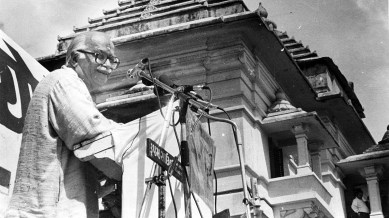From Swayamsevak to the man behind the rise of BJP in India: The journey of LK Advani
On Saturday, Prime Minister Narendra Modi announced that LK Advani will be conferred with the prestigious Bharat Ratna, India’s highest civilian award.

From joining the Rashtriya Swayamsevak Sangh (RSS) to being regarded as the leader responsible for the Bharatiya Janata Party (BJP’s) ascension to the top of Indian polity, Lal Krishna Advani’s long political innings has seen multiple ups and downs.
On Saturday, Prime Minister Narendra Modi announced that Advani will be conferred with the Bharat Ratna, India’s highest civilian award. In a post shared on social media platform X, the Prime Minister said: “The conferring of the Bharat Ratna on him is a very emotional moment for me. Advani Ji’s decades-long service in public life has been marked by an unwavering commitment to transparency and integrity, setting an exemplary standard in political ethics.”
Early Life
Born in Karachi on November 8, 1927, Advani joined the RSS in 1942 and re-located to Delhi from Sindh in 1947 during Partition. It was in early 1957 when he forayed into mainstream politics as he started assisting Atal Bihari Vajpayee and the other newly elected Jana Sangh MPs in their parliamentary work.
In 1958, he became the secretary of the Delhi State Jana Sangh. Besides this role, he also began a new chapter in his life as a journalist, joining Organiser as an Assistant Editor in 1960. However, this stint did not last long as he left the role in 1967 to move to full-time politics.
In April 1970, Rajya Sabha had a vacancy after the end of the term of Inder Kumar Gujral, who served as the 13th Prime Minister of India from April 21, 1997, to March 19, 1998 . The Jana Sangh fielded Advani and he was elected owing to the party’s majority in the Council. It is at this point where he moved from the Delhi’s civic council to the Parliament.
Life in Politics
During his long political innings, Advani occupied several important party and government posts, including Deputy Prime Minister, Leader of Opposition, and BJP president. After the dissolution of the Janata Party government, Advani, along with Vajpayee, had helped establish the BJP as the political arm of RSS.
The BJP’s turn towards supporting the VHP’s Ram Temple demand began when Advani replaced Vajpayee as party president in 1986, two years after its 1984 debacle when it was reduced to just two Lok Sabha seats. The BJP under Advani formally supported the Ram Temple demand at its Palampur session in June 1989, a move that made Jaswant Singh walk all the way to the railway station in disapproval.
The yatra garnered a massive public response, but also led to riots at some places. However, it catapulted Advani to the centre of national politics. The BJP decided that if Advani were to be arrested, it would withdraw its support to the VP Singh government. The arrest happened in Samastipur, Bihar, with the government of then CM Lalu Prasad arresting Advani on the night of October 22, 1990, and flying him to a guest house in Dumka, now in Jharkhand. The BJP withdrew support to the VP Singh government, which fell.
After spending months taking his Rath Yatra across the country, Advani finally entered Ayodhya to carry out kar seva that eventually, on December 6, 1992, led to the demolition of the Babri Masjid.
Advani is often credited for taking the BJP from two Parliamentary seats in 1984 to forming a government in 15 years. He rose to be Deputy PM under Vajpayee, and also after the loss in the 2004 general elections, he steered the BJP as the president of the party.
The controversies surrounding him
Advani has been at the centre of an array of controversies. In 1991, arrest of militants in Kashmir had led to raids on Hawala brokers which brought to light a series of large-scale payments to national leaders, including Advani. However, the Supreme Court, later, disposed of the case owing to lack of evidence.
During his visit to Pakistan in 2005, Advani had stunned both the party and the Sangh by declaring Muhammad Ali Jinnah as a secular leader. Upon his return, he was forced to resign as the BJP president.
In 2013, he was at the centre of news as following the anointment of Narendra Modi as BJP campaign committee chairman for the 2014 Lok Sabha elections, he resigned from all party posts.